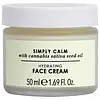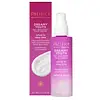What's inside
What's inside
 Key Ingredients
Key Ingredients

 Benefits
Benefits

 Concerns
Concerns

 Ingredients Side-by-side
Ingredients Side-by-side

Water
Skin ConditioningGlycerin
HumectantEthylhexyl Palmitate
EmollientButyrospermum Parkii Butter
Skin ConditioningPolyglyceryl-6 Distearate
EmulsifyingCannabis Sativa Seed Oil
EmollientCetyl Alcohol
EmollientCaprylic/Capric Triglyceride
MaskingStearic Acid
CleansingPhenoxyethanol
PreservativeVitis Vinifera Seed Oil
EmollientPanthenol
Skin ConditioningCarbomer
Emulsion StabilisingSodium Stearoyl Glutamate
CleansingCaprylyl Glycol
EmollientSodium Hyaluronate
HumectantAloe Barbadensis Leaf Juice
Skin ConditioningXanthan Gum
EmulsifyingEthylhexylglycerin
Skin ConditioningPotassium Hydroxide
BufferingSodium Phytate
Citrullus Lanatus Seed Oil
EmollientHexylene Glycol
EmulsifyingTocopherol
AntioxidantTetrahexyldecyl Ascorbate
AntioxidantLimonene
PerfumingHelianthus Annuus Seed Oil
EmollientLavandula Angustifolia Oil
MaskingCucumis Sativus Fruit Extract
EmollientTheobroma Cacao Extract
Skin ConditioningCitrus Nobilis Peel Oil
MaskingHyssopus Officinalis Flower/Leaf/Stem Oil
MaskingLinalool
PerfumingWater, Glycerin, Ethylhexyl Palmitate, Butyrospermum Parkii Butter, Polyglyceryl-6 Distearate, Cannabis Sativa Seed Oil, Cetyl Alcohol, Caprylic/Capric Triglyceride, Stearic Acid, Phenoxyethanol, Vitis Vinifera Seed Oil, Panthenol, Carbomer, Sodium Stearoyl Glutamate, Caprylyl Glycol, Sodium Hyaluronate, Aloe Barbadensis Leaf Juice, Xanthan Gum, Ethylhexylglycerin, Potassium Hydroxide, Sodium Phytate, Citrullus Lanatus Seed Oil, Hexylene Glycol, Tocopherol, Tetrahexyldecyl Ascorbate, Limonene, Helianthus Annuus Seed Oil, Lavandula Angustifolia Oil, Cucumis Sativus Fruit Extract, Theobroma Cacao Extract, Citrus Nobilis Peel Oil, Hyssopus Officinalis Flower/Leaf/Stem Oil, Linalool
Water
Skin ConditioningHelianthus Annuus Seed Oil
EmollientEthylhexylglyceryl Palmitate
EmulsifyingAcetyl Hexapeptide-8
HumectantGlyceryl Stearate
EmollientCetyl Alcohol
EmollientPalmitoyl Tripeptide-3
Butyrospermum Parkii Oil
EmollientVitis Vinifera Seed Oil
EmollientAloe Barbadensis Leaf Juice
Skin ConditioningLaminaria Hyperborea Extract
Skin ProtectingTocopheryl Acetate
AntioxidantMagnesium Ascorbyl Phosphate
AntioxidantPrunus Amygdalus Dulcis Oil
Skin ConditioningHyaluronic Acid
HumectantTheobroma Cacao Seed Butter
EmollientPanthenol
Skin ConditioningAllantoin
Skin ConditioningXanthan Gum
EmulsifyingAlgin
MaskingAvena Sativa Bran
AbrasiveCocos Nucifera Water
MaskingIris Pallida Leaf Cell Extract
AntioxidantRosa Damascena Leaf Cell Extract
Skin ProtectingCichorium Intybus Root Oligosaccharides
Skin ConditioningCaesalpinia Spinosa Gum
Skin ConditioningCucumis Sativus Fruit Extract
EmollientPhenoxyethanol
PreservativeEthylhexylglycerin
Skin ConditioningPelargonium Graveolens Oil
MaskingWater, Helianthus Annuus Seed Oil, Ethylhexylglyceryl Palmitate, Acetyl Hexapeptide-8, Glyceryl Stearate, Cetyl Alcohol, Palmitoyl Tripeptide-3, Butyrospermum Parkii Oil, Vitis Vinifera Seed Oil, Aloe Barbadensis Leaf Juice, Laminaria Hyperborea Extract, Tocopheryl Acetate, Magnesium Ascorbyl Phosphate, Prunus Amygdalus Dulcis Oil, Hyaluronic Acid, Theobroma Cacao Seed Butter, Panthenol, Allantoin, Xanthan Gum, Algin, Avena Sativa Bran, Cocos Nucifera Water, Iris Pallida Leaf Cell Extract, Rosa Damascena Leaf Cell Extract, Cichorium Intybus Root Oligosaccharides, Caesalpinia Spinosa Gum, Cucumis Sativus Fruit Extract, Phenoxyethanol, Ethylhexylglycerin, Pelargonium Graveolens Oil
Ingredients Explained
These ingredients are found in both products.
Ingredients higher up in an ingredient list are typically present in a larger amount.
Aloe Barbadensis Leaf Juice comes from leaves of the aloe plant. Aloe Barbadensis Leaf Juice is best known for helping to soothe sunburns. It is also anti-inflammatory, moisturizing, antiseptic, and can help heal wounds.
Aloe is packed with good stuff including Vitamins A, C, and E. These vitamins are antioxidants, which help fight free-radicals and the damage they may cause. Free-radicals are molecules that may damage your skin cells, such as pollution.
Aloe Barbadensis Leaf Juice also contains sugars. These sugars come in the form of monosaccharides and polysaccharides, folic acid, and choline. These sugars are able to help bind moisture to skin.
It also contains minerals such as calcium, 12 anthraquinones, fatty acids, amino acids, and Vitamin B12.
Learn more about Aloe Barbadensis Leaf JuiceCetyl Alcohol is a fatty alcohol. Fatty Alcohols are most often used as an emollient or to thicken a product.
Its main roles are:
Though it has "alcohol" in the name, it is not related to denatured alcohol or ethyl alcohol.
The FDA allows products labeled "alcohol-free" to have fatty alcohols.
Learn more about Cetyl AlcoholThis extract comes from cucumber. Cucumbers are mostly made up of water (95%), and the other 5% is composed of: vitamin C, caffeic acid, fatty acids, amino acids, and other minerals.
Cucumbers have anti-inflammatory, barrier repair, and hydrating properties.
They contain shikimate dehydrigenase, an enzyme shown to help reduce inflammation and soothe the skin.
The amino acids found in cucumbers help nourish our skin's natural acid mantle (it's an important part of our skin barrier). This slightly acidic film acts as a barrier to protect us from bacteria, viruses, and other contaminants.
Unless you have an allergy to cucumbers, this is generally a non-irritating ingredient.
Fun fact: Cucumis Sativus is native to South Asia and can now be found on every continent.
Learn more about Cucumis Sativus Fruit ExtractEthylhexylglycerin (we can't pronounce this either) is commonly used as a preservative and skin softener. It is derived from glyceryl.
You might see Ethylhexylglycerin often paired with other preservatives such as phenoxyethanol. Ethylhexylglycerin has been found to increase the effectiveness of these other preservatives.
Helianthus Annuus Seed Oil is the oil derived from the seeds of a Sunflower. Sunflower seed oil is non-fragrant. It is an emollient, meaning it helps to soften the skin.
Sunflower seed oil contains many fatty acids. The fatty acids found in sunflower seeds include (from highest amount to least): linoleic acid, myristic acid, palmitic acid, stearic acid, arachidic acid, oleic acid, and linolenic acid.
These fatty acids help the skin create ceramides. Ceramides play a role in repairing the skin barrier.
Helianthus Annuus Seed Oil helps moisturize the skin. This in turn helps the skin look more rejuvenated and smoother.
Sunflowers are rich in vitamin E.
Historians believe Indigenous cultures of North America domesticated sunflowers before corn. Thus they relied on sunflower oil for a variety of uses. One such use is moisturizing skin and hair.
Sunflower seed oil may not be fungal acne safe. We recommend speaking with a professional if you have any concerns.
Learn more about Helianthus Annuus Seed OilPanthenol is a common ingredient that helps hydrate and soothe the skin. It is found naturally in our skin and hair.
There are two forms of panthenol: D and L.
D-panthenol is also known as dexpanthenol. Most cosmetics use dexpanthenol or a mixture of D and L-panthenol.
Panthenol is famous due to its ability to go deeper into the skin's layers. Using this ingredient has numerous pros (and no cons):
Like hyaluronic acid, panthenol is a humectant. Humectants are able to bind and hold large amounts of water to keep skin hydrated.
This ingredient works well for wound healing. It works by increasing tissue in the wound and helps close open wounds.
Once oxidized, panthenol converts to pantothenic acid. Panthothenic acid is found in all living cells.
This ingredient is also referred to as pro-vitamin B5.
Learn more about PanthenolPhenoxyethanol is a preservative that has germicide, antimicrobial, and aromatic properties. Studies show that phenoxyethanol can prevent microbial growth. By itself, it has a scent that is similar to that of a rose.
It's often used in formulations along with Caprylyl Glycol to preserve the shelf life of products.
Vitis Vinifera Seed Oil comes from the grape vine. Grape seeds are a byproduct of creating grape juice or wine.
The components of grape seeds have many skin benefits. Research has found it to be antimicrobial and anti-inflammatory. It also contains many potent antioxidants such as Vitamin E , Vitamin C, proanthocyanidins, polyphenols, flavonoids, and anthocyanins. Proanthocyanidin has been shown to help even out skin tone.
Antioxidants help fight free-radical molecules. Free-radical molecules are capable of damaging our cells and other genetic material. Antioxidants help stabilize free-radicals by donating extra electrons. Grape seed extract may help reduce the signs of aging.
The antimicrobial properties of grape seed may help treat acne. However, more research is needed to support this claim.
Grape seed has also been found to help absorb UV rays. Grape seed extract should not replace your sunscreen.
The fatty acids of grape seed oil give it emollient properties. Emollients help soothe and soften your skin by creating a film. This film traps moisture within, keeping your skin hydrated.
Learn more about Vitis Vinifera Seed OilWater. It's the most common cosmetic ingredient of all. You'll usually see it at the top of ingredient lists, meaning that it makes up the largest part of the product.
So why is it so popular? Water most often acts as a solvent - this means that it helps dissolve other ingredients into the formulation.
You'll also recognize water as that liquid we all need to stay alive. If you see this, drink a glass of water. Stay hydrated!
Learn more about WaterXanthan gum is used as a stabilizer and thickener within cosmetic products. It helps give products a sticky, thick feeling - preventing them from being too runny.
On the technical side of things, xanthan gum is a polysaccharide - a combination consisting of multiple sugar molecules bonded together.
Xanthan gum is a pretty common and great ingredient. It is a natural, non-toxic, non-irritating ingredient that is also commonly used in food products.
Learn more about Xanthan Gum